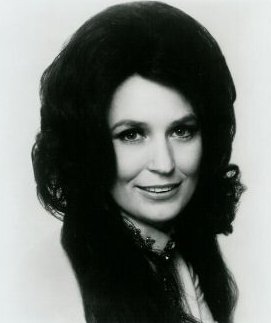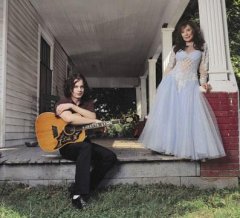Graham Reid | | 8 min read
Loretta Lynn: The Other Woman (1963)

The ugliest baby I ever
saw -- a pug-faced killer-midget with malevolent eyes -- was at
Loretta Lynn’s
place.
Then again, there was
plenty of ugly, kitschy, evil and just plain tacky stuff at the home
of this country music legend.
But I’ll
be forgiving, and say that maybe the baby just looked bad in
comparison with the delightful setting of Hurricane Mills, the
property Loretta bought in the late Sixtiess and which included a working
mill beside a pretty lake, and rolling fields in the lush landscapes
of east Tennessee about an hour from the capital of country music,
Nashville.
We had been driving to
Nashville on Interstate 40 when a sign loomed up on the highway
ahead: Loretta Lynn Dude Ranch.
Not having read her autobiography Coal Miner’s Daughter -- or having seen the 1980 film adaptation in which Sissy Spacek played Lynn and Tommy Lee Jones was Lynn’s husband Doolittle -- I had no idea Loretta had a ranch open to the public.
But the thought of it is too good to miss, so we pull off the
highway and drive to a restaurant-cum-gift shop on a hill above the
side road where Loretta’s
name was bannered large above the entrance.
Lynn -- who made her name
with appealingly earthy and honest songs like Don‘t
Come Home A Drinkin’
(With Lovin’
On Your Mind), The Other Woman, and Who’s
Gonna Take The Garbage Out -- is a country star of the old
kind. Her story of rags-to-riches has been told in her
autobiographical songs and two volumes of her life story (Coal
Miner’s
Daughter and the repetitive sequel Still Woman
Enough).
She sang of cheatin’
husbands, bein’
poor but still havin’
dignity, of belief in God when the world has done you wrong, and of
lost love. Loretta knew all these things from bitter experience.

That was the dude ranch,
this was just the merchandise store.
We drive through fragrant
countryside lined with wildflowers, cross Duck River (where Loretta’s
son Jack drowned in 84) and the road narrows to almost a single lane
through a silent forest. Down a broad driveway on our left is
Hurricane Mills, a small town of the original post office, a few
other buildings and the mill and wheel beside a flat pond.
It is as purty as a
picture and facing it across the river is the white columned house
which Loretta and Doo moved in to in early 67.

“It looked like a
hillbilly‘s
dream.”
Loretta -- and Doo, who
died in 96 -- moved out in the late 70s after fans just kept turning
up to the door (and some tempting boozy Doo off for drinks). But the
house has been kept as it was when they lived there.
And it’s
tacky.
Lynn’s
early life was unashamedly tough and she has written and sung about
how she grew up in remote Butcher Holler in Kentucky. She went to a
one-room school; their single-room handmade cabin was wallpapered
with pages from magazines; she wore flour sacks as a child and slept
on the floor until she was nine; and her father worked in the mine.
On the day of her wedding
in the local courthouse she needed to go to the toilet so Doo took
her to the bus station. She’d
never seen indoor plumbing and was terrified by the flushing.
 Doo called her a stupid
hillbilly -- and Lynn admits she was. But forgive her, she was young.
Doo called her a stupid
hillbilly -- and Lynn admits she was. But forgive her, she was young.
Loretta married Doo when
she was 14 -- he was in his 20s and had fought in Europe in World War
II -- and had no idea how babies were made. She had four by the time
she was 18.
What separates Lynn from
many other successful country artists is she genuinely hasn’t
changed her attitudes: she doesn’t
know big words and doesn’t
pretend to; and admits to some hilarious gaffes.
When she was invited to a
Dean Martin Celebrity Roast for Jack Lemmon she didn’t
have any lunch that day. She was looking forward to the roast meat
and potatoes later.
Ernest Tubb, the country
legend who helped her career in the early 60s, said she was the only
person he’d
met -- and through the Grand Ole Opry he’d
met ’em
all -- who didn’t
change after she became famous.
Lynn has known six
presidents and in Still Woman Enough she says she
counted two of ’em
as friends, Jimmy Carter and the first George Bush. Of course she
supported George the Younger.
Yet while she has mixed
with the great and the good -- and the not-so-good -- she also
remembered what being poor felt like and so wasted nothing.
She kept the packaging
that perfume bottles came in and at Hurricane Mills there is a museum
filled with her dresses, concert posters, memorabilia and her old
tour bus.
Shortly after Doo first
met Loretta he gave her a baby doll for Christmas and said that when
they were married they would have a real live doll.
“I didn’t
know what he was talking about,”
she later said.
But, like most things in
her life, she kept that gift. The child-bride was, after all, still
playing with dolls.
Over the years as she
became wealthy they added to Hurricane Mills.

The day we dropped by
there we were a dozen other visitors to Hurricane Mills, among them a
couple who -- and I dislike myself for making this observation --
could have been siblings and had two slightly unusual looking
children with them.
The man was ill-shaven and
wore ragged denim overalls, and the woman a baggy hand-me-down dress.
They tip-toed around Loretta’s
house and gazed in awe at the hideously carved Indian kitsch on the
walls (Loretta was proud of her Cherokee heritage) and the cabinets
Doo built to house her collection of salt and pepper shakers and such
like.
 They became reverently
silent at the sight of her gold and platinum discs in the stairwell,
and in the garden took dozens of photos of the hideous job-lot
statuary.
They became reverently
silent at the sight of her gold and platinum discs in the stairwell,
and in the garden took dozens of photos of the hideous job-lot
statuary.
These people --
worshippers in the church of country -- were Loretta’s
true fans and the people who gave her the career she has had. And she
never forgot it.
Hurricane Mills has trail
rides, camping grounds, fishing holes, regular concerts and an annual
MotorCross Championship. Loretta’s
constituency turns up in their thousands during the year and make the
pilgrimage to her house like others visit the Vatican or Buckingham
Palace.
“Horses down that away”
reads a sign.
I could only be cynical at
the reconstruction of the mine her daddy worked in -- it was kinda
dark and scary in there though -- but was impressed by the ebb and
flow of her career as outlined in the massive museum of her
memorabilia.
 In '04 Lynn released an
album with Jack White of the White Stripes, and so Loretta -- at 69
-- was a cool name to drop among the hip set. People who’d
previously never heard a note she’d
sung suddenly confessed to being longtime closet fans.
In '04 Lynn released an
album with Jack White of the White Stripes, and so Loretta -- at 69
-- was a cool name to drop among the hip set. People who’d
previously never heard a note she’d
sung suddenly confessed to being longtime closet fans.
In a reminder of what a
footnote in her long career that association had been, two posters of
concerts with White stacked in a corner near the toilets.
But she had kept them,
just as she kept and displayed the gifts from fans.
Beside the shop was her
doll museum.
That is where I saw the
brutally ugly baby, in a glass case beside the Native American dolls,
those in chintzy wedding gowns, or dressed as cowgirls in gingham.
Awful stuff, all of it.
 The ugly baby was on its
hands and knees, it’s
oddly distorted face twisted up into something between a snarl, a
grimace and a plea for help.
The ugly baby was on its
hands and knees, it’s
oddly distorted face twisted up into something between a snarl, a
grimace and a plea for help.
It‘s
pinched eyes were almost Satanic and, most curious of all, its
nappies were pulled down to reveal a round firm bottom raised in the
air.
It looked . . . well, creepy actually.
And not a little perverted.
I’m
sure that other couple and their kids will never forget the day they
went to Loretta Lynn’s
place.
Nor will I.
But for entirely different reasons.
This was a chapter in the travel collection The Idiot Boy Who Flew, see here.
Want to read more along these lines of music and travel? Then check out this one, a journey to Robert Johnson's crossroads.







post a comment